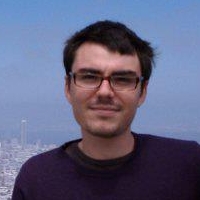PhiloGL 1.4.0
I’m very excited to announce that PhiloGL version 1.4.0 has been released!
This release focuses on two main things: a better picking algorithm that caches scene rendering and a simple image post-processing chain to add some nice fragment shader effects when rendering a scene.
Both these features are implemented in a revamped World Flights example I just released, so let’s take a look at how these things are implemented in the example.
World Flights (revisited)

World Flights is a data visualization that shows flying routes information for various airlines around the world. For 200 airlines, more than 57.000 flights and 6.000 destinations are displayed. You can find more information on the example here.
You can access the example here.
Image post processing
There’s a nice neon effect in the airline routes as well as in the cities displayed in this example. This is done by rendering two different scenes; one with a “black” planet:

…and another one with the current texture for the planet:

Here’s the code that renders them to a world and world2 FBOs
and their associated world-texture and world2-texture textures:
app.setFrameBuffer('world', true);
program.earth.use();
gl.clear(clearOpt);
gl.viewport(0, 0, 1024, 1024);
//do not use a texture but paint it black
program.earth.setUniform('renderType', 0);
scene.renderToTexture('world');
app.setFrameBuffer('world', false);
app.setFrameBuffer('world2', true);
program.earth.use();
gl.clear(clearOpt);
gl.viewport(0, 0, 1024, 1024);
//use a regular planet texture
program.earth.setUniform('renderType', -1);
scene.renderToTexture('world2');
app.setFrameBuffer('world2', false);These two textures are then combined to generate the screen image:
Media.Image.postProcess({
fromTexture: ['world-texture', 'world2-texture'],
toScreen: true,
program: 'glow',
width: 1024,
height: 1024
});The glow fragment shader will take these two generated textures,
create a bloom filter for the one with the black planet, and add it to the
one that has the regular textured planet and provide a result for that:
#ifdef GL_ES
precision highp float;
#endif
#define BLUR_LIMIT 4
#define BLUR_LIMIT_SQ 64.0
varying vec2 vTexCoord1;
uniform bool hasTexture1;
uniform sampler2D sampler1;
uniform bool hasTexture2;
uniform sampler2D sampler2;
void main(void) {
vec4 fragmentColor = vec4(0.0, 0.0, 0.0, 0.0);
float dx;
float dy;
if (hasTexture1 && hasTexture2) {
//Add glow
for (int i = - BLUR_LIMIT; i < BLUR_LIMIT; i++) {
dx = float(i) / 512.0;
for (int j = - BLUR_LIMIT; j < BLUR_LIMIT; j++) {
dy = float(j) / 512.0;
fragmentColor += texture2D(sampler1, vec2(vTexCoord1.s + dx, vTexCoord1.t + dy)) / BLUR_LIMIT_SQ;
}
}
//Add real image
fragmentColor += texture2D(sampler2, vec2(vTexCoord1.s, vTexCoord1.t));
}
gl_FragColor = vec4(fragmentColor.rgb, 1.0);
}This is not the best way to make a bloom filter since it’s O(N * N), but
it could be easily transformed into a two-pass bloom filter with the
postProcess chaining API:
//Make a horizontal pass
Media.Image.postProcess({
fromTexture: 'world2-texture',
toFrameBuffer: 'bloom1',
program: 'bloom',
width: 1024,
height: 1024,
uniforms: {
'orientation': 1
}
//Make a vertical pass on the result
}).postProcess({
fromTexture: 'bloom1-texture',
toFrameBuffer: 'bloom2',
program: 'bloom',
width: 1024,
height: 1024,
uniforms: {
'orientation': 0
}
//Combine the result to the original texture
}).postProcess({
fromTexture: ['world-texture', 'bloom2-texture'],
toScreen: true,
program: 'glow',
width: 1024,
height: 1024
});The result is:

Lazy Picking
The World Flights example displays around 6.000 cities served by the airlines. If you hover those cities a tooltip will display showing information about the city:

As mentioned in older posts, I implemented the color picking algorithm which assigns a different “picking color” to each city, then renders all 6000 cities to a texture with those picking colors and retrieves the color of the pixel pointed by the mouse. From that color it’s easy to identify which city has been hovered.
The current algorithm though renders this alternate scene each time the mouse moves over the canvas. A better approach would be to only take a snapshot of the scene when it’s updated in some way (the planet is dragged and dropped, a new airline is selected and the earth moves, etc.).
This can now be done by setting lazyPicking to true and then using a
scene.resetPicking() method when the time is right to take a new
snapshot. For all other cases a cache of the capture stored in a typed
array will be used improving the performance of the algorithm:
events: {
//enable picking and lazy picking
picking: true,
lazyPicking: true,
//remove the center origin option for picking
centerOrigin: false,
onDragStart: function(e) {
//do stuff...
},
onDragMove: function(e) {
//do stuff to rotate the earth...
},
onDragEnd: function(e) {
//reset the picking by removing the cached image capture
this.scene.resetPicking();
},
//more code here...You can find more information on both these features in the Media and Scene APIs.
Thanks
Thanks to Luz Caballero for helping me out with the design of World Flights!





